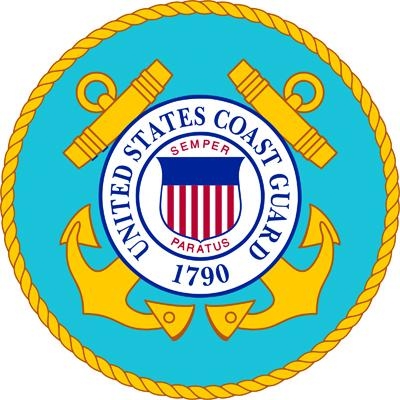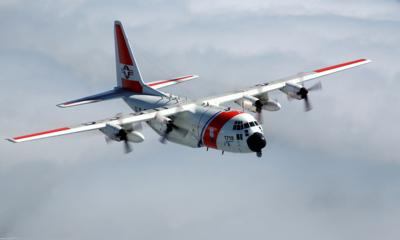Multi-Asset Search Saves Lives
On Monday, 14 August 2023, the United States Coast Guard and Navy rescued four divers—Ben Wiggins, 64; Luke Lodge, 26; Daniel Williams, 46; and Evan Williams, 16—gone missing some forty-nautical-miles southeast of North Carolina’s Cape Fear.

A Coast Guard Air Station Elizabeth City HC-130 Hercules crew notified Coast Guard Sector North Carolina watchstanders at 00:45 EDT on the morning of 14 August that they’d spotted an SOS-strobe light, located the four missing divers, and launched a life raft. The HC-130 coordinated a rescue effort with the U.S. Navy Destroyer USS Porter (DDG 78), then conducting a training exercise near the divers’ location. The Porter arrived on scene and crew-members safely retrieved all four divers from the life raft.
A Coast Guard Station Oak Island Motor Lifeboat rendezvoused with the Porter and transferred the exhausted divers aboard. The boat-crew arrived at Coast Guard Station Oak Island at approximately 06:10 EDT and reunited the beleaguered-but-breathing divers with friends and family.
Coast Guard Sector North Carolina Commander Captain Timothy List stated: “Any time the Coast Guard launches for a search and rescue case, it is always our hope and goal to be able to reunite those we are searching for with their friends and families. In this case that is exactly what took place, which is always a great feeling for our rescue crews.”
On Sunday, 13 August, watchstanders at Coast Guard Sector North Carolina received notification from Coast Guard Sector Charleston that four men diving from a pleasure craft dubbed Big Bill’s approximately 55-nautical-miles east of Myrtle Beach, South Carolina had not resurfaced.
Sectors Charleston and North Carolina subsequently coordinated a multi-asset search and rescue effort.
Participating rescue crews included: an MH-60 Jayhawk helicopter aircrew from Coast Guard Air Station Elizabeth City, North Carolina; an HC-130 Hercules aircraft crew from Air Station Elizabeth City; a 47-foot Motor Lifeboat crew from Coast Guard Station Oak Island, North Carolina; the Coast Guard Cutter Sailfish, an 87-foot patrol boat from Portsmouth, Virginia; the Coast Guard Cutter Yellowfin, an 87-foot patrol boat from Charleston, South Carolina; and the U.S. Navy Destroyer USS Porter (DDG 78).
Created by Congress as the Revenue-Marine on 04 August 1790, the U.S. Coast Guard (USCG) is the oldest continuously operating naval service of the United States. The Semper Paratus (Always Ready) motto to which the Coast Guard aspires speaks to the outfit’s ethos and the nature of its humanitarian and security missions.
Stated simply, the Coast Guard protects the United States' borders and defends her sovereignty by safeguarding sea lines of communication and commerce across 95,000-miles of U.S. coastline and the entirety of the U.S. Exclusive Economic Zone. This critical work is carried out by 44,500 active-duty personnel, 7,000 reservists, and 8,577 full-time civilian employees.

The USCG’s fleet of roughly 250 coastal and ocean-going cutters, patrol ships, buoy tenders, tugs, and icebreakers; as well as nearly two-thousand small boats and specialized craft constitutes the world’s 12th largest naval force. The service’s aviation division comprises north of two-hundred helicopters and fixed-wing aircraft the likes of the AC-37A (Gulfstream V), HC-144A (Airbus CN-235), and Lockheed’s mighty HC-130 Hercules utility turboprop transport. To supplement the aforementioned and better support its homeland security and search & rescue operations, the Coast Guard is building an unmanned aerial vehicle (UAV) program around General Atomics’ MQ-9 Reaper platform.
In its humanitarian capacity, the U.S. Coast Guard saves tens-of-thousands of lives every year and provides emergency response and disaster management for all manner of man-made emergencies, meteorological exigencies, and outright natural disasters.
 ANN's Daily Aero-Term (04.26.24): DETRESFA (Distress Phrase)
ANN's Daily Aero-Term (04.26.24): DETRESFA (Distress Phrase) Aero-News: Quote of the Day (04.26.24)
Aero-News: Quote of the Day (04.26.24) ANN's Daily Aero-Term (04.27.24): Direct
ANN's Daily Aero-Term (04.27.24): Direct ANN's Daily Aero-Linx (04.27.24)
ANN's Daily Aero-Linx (04.27.24) Aero-News: Quote of the Day (04.27.24)
Aero-News: Quote of the Day (04.27.24)




